Preparation of Copper Nitride Films with Superior Photocatalytic Activity through Magnetron Sputtering
Abstract
:1. Introduction
2. Experiment
3. Results and Discussion
4. Conclusions
Author Contributions
Funding
Conflicts of Interest
References
- Ren, X.; Qi, X.; Shen, Y.; Xiao, S.; Xu, G.; Zhang, Z.; Huang, Z.; Zhong, J. 2D co-catalytic MoS2nanosheets embedded with 1D TiO2nanoparticles for enhancing photocatalytic activity. J. Phys. D Appl. Phys. 2016, 49, 315304. [Google Scholar] [CrossRef]
- Ge, M.; Cai, J.; Iocozzia, J.; Cao, C.; Huang, J.; Zhang, X.; Shen, J.; Wang, S.; Zhang, S.; Zhang, K.-Q.; et al. A review of TiO2 nanostructured catalysts for sustainable H 2 generation. Int. J. Hydrog. Energy 2017, 42, 8418–8449. [Google Scholar] [CrossRef]
- Yang, H.G.; Sun, C.; Qiao, S.-Z.; Zou, J.; Liu, G.; Smith, S.C.; Cheng, H.-M.; Lu, G. Anatase TiO2 single crystals with a large percentage of reactive facets. Nature 2008, 453, 638–641. [Google Scholar] [CrossRef] [Green Version]
- Wang, X.; Yang, B.; Zhou, K.; Zhang, D.; Li, Z.; Zhou, C. Ordered porous TiO2 films obtained by freezing and the application in dye sensitized solar cells. Curr. Appl. Phys. 2015, 15, 662–668. [Google Scholar] [CrossRef]
- Huang, J.; Shen, J.; Li, S.; Cai, J.; Wang, S.; Lu, Y.; He, J.; Carmalt, C.J.; Parkin, I.P.; Lai, Y. TiO2 nanotube arrays decorated with Au and Bi2S3 nanoparticles for efficient Fe3+ ions detection and dye photocatalytic degradation. J. Mater. Sci. Technol. 2020, 39, 28–38. [Google Scholar] [CrossRef]
- Ansari, S.A.; Khan, M.M.; Ansari, M.O.; Cho, M.H. Nitrogen-doped titanium dioxide (N-doped TiO2) for visible light photocatalysis. New J. Chem. 2016, 40, 3000–3009. [Google Scholar] [CrossRef]
- Hu, X.; Xiong, J.; Tang, Y.; Zhou, C.; Yang, J. Interface modification of polymer solar cells using graphene oxide and TiO2 NPs. Phys. Status Solidi 2014, 212, 585–590. [Google Scholar] [CrossRef]
- Xu, L.; Wan, F.; Rong, Y.; Chen, H.; He, S.; Xu, X.; Liu, G.; Han, H.; Yuan, Y.; Yang, J.; et al. Stable monolithic hole-conductor-free perovskite solar cells using TiO2 nanoparticle binding carbon films. Org. Electron. 2017, 45, 131–138. [Google Scholar] [CrossRef]
- Zhang, D.; Liu, W.; Tang, L.; Zhou, K.; Luo, H. High performance capacitors via aligned TiO2 nanowire array. Appl. Phys. Lett. 2017, 110, 133902. [Google Scholar] [CrossRef]
- Cheng, L.; Xiang, Q.; Liao, Y.; Zhang, H. CdS-Based photocatalysts. Energy Environ. Sci. 2018, 11, 1362–1391. [Google Scholar] [CrossRef]
- Zhu, B.; Wang, F.; Zhang, K.; Zhang, J.; Gu, Y. Enhanced three-photon absorption in CdSe/CdS core/shell nanocrystals in near-infrared. Appl. Phys. Express 2016, 9, 82602. [Google Scholar] [CrossRef]
- Gou, G.; Dai, G.; Wang, X.; Chen, Y.; Qian, C.; Kong, L.; Sun, J.; Yang, J. High-performance and flexible photodetectors based on P3HT/CdS/CdS:SnS2 superlattice nanowires hybrid films. Appl. Phys. A 2017, 123, 731. [Google Scholar] [CrossRef]
- Gou, G.; Dai, G.; Qian, C.; Liu, Y.; Fu, Y.; Tian, Z.; He, Y.; Kong, L.; Yang, J.; Sun, J.; et al. High-performance ultraviolet photodetectors based on CdS/CdS:SnS2 superlattice nanowires. Nanoscale 2016, 8, 14580–14586. [Google Scholar] [CrossRef] [PubMed]
- Kim, K.J.; Kim, J.H.; Kang, J.H. Structural and optical characterization of Cu3N films prepared by reactive RF magnetron sputtering. J. Cryst. Growth 2001, 222, 767–772. [Google Scholar] [CrossRef]
- Jiang, A.; Qi, M.; Xiao, J. Preparation, structure, properties, and application of copper nitride (Cu3N) thin films: A review. J. Mater. Sci. Technol. 2018, 34, 1467–1473. [Google Scholar] [CrossRef]
- Yu, A.; Hu, R.; Liu, W.; Zhang, R.; Zhang, J.; Pu, Y.; Chu, L.; Yang, J.; Li, X. Preparation and characterization of Mn doped copper nitride films with high photocurrent response. Curr. Appl. Phys. 2018, 18, 1306–1312. [Google Scholar] [CrossRef]
- Yee, Y.S.; Inoue, H.; Hultqvist, A.; Hanifi, D.; Salleo, A.; Magyari-Kope, B.; Nishi, Y.; Bent, S.F.; Clemens, B.M. Copper interstitial recombination centers in Cu3N. Phys. Rev. B 2018, 97, 245201. [Google Scholar] [CrossRef] [Green Version]
- Maruyama, T.; Morishita, T. Copper nitride thin films prepared by radio-frequency reactive sputtering. J. Appl. Phys. 1995, 78, 4104–4107. [Google Scholar] [CrossRef] [Green Version]
- Jiang, A.; Xiao, J.; Gong, C.; Wang, Z.; Ma, S. Structure and electrical transport properties of Pb-doped copper nitride (Cu3N:Pb) films. Vacuum 2019, 164, 53–57. [Google Scholar] [CrossRef]
- Kuzmin, A.; Kalinko, A.; Anspoks, A.; Timoshenko, J.; Kalendarev, R. Study of Copper Nitride Thin Film Structure. Latv. J. Phys. Tech. Sci. 2016, 53, 31–37. [Google Scholar] [CrossRef] [Green Version]
- Timoshenko, J.; Anspoks, A.; Kalinko, A.; Kuzmin, A. Thermal disorder and correlation effects in anti-perovskite-type copper nitride. Acta Mater. 2017, 129, 61–71. [Google Scholar] [CrossRef] [Green Version]
- Wu, Z.; Chen, H.; Gao, N.; Yang, J.; Yang, T.; Zhang, J.; Li, X.; Yao, K. Ab initio calculations of the structural, elastic, electronic and optical properties of Cu3NM compounds doped with M=Sc, Y and La. Solid State Commun. 2015, 201, 9–14. [Google Scholar] [CrossRef]
- Xiao, J.; Qi, M.; Gong, C.; Wang, Z.; Jiang, A.; Ma, J.; Cheng, Y. Crystal structure and optical properties of silver-doped copper nitride films (Cu3N:Ag) prepared by magnetron sputtering. J. Phys. D Appl. Phys. 2018, 51, 055305. [Google Scholar] [CrossRef]
- Majumdar, A.; Drache, S.; Wulff, H.; Mukhopadhyay, A.K.; Bhattacharyya, S.; Helm, C.A.; Hippler, R. Strain Effects by Surface Oxidation of Cu3N Thin Films Deposited by DC Magnetron Sputtering. Coatings 2017, 7, 64. [Google Scholar] [CrossRef]
- Yu, A.; Ma, Y.; Chen, A.; Li, Y.; Zhou, Y.; Wang, Z.; Zhang, J.; Chu, L.; Yang, J.; Li, X. Thermal stability and optical properties of Sc-doped copper nitride films. Vacuum 2017, 141, 243–248. [Google Scholar] [CrossRef]
- Szczęsny, R.; Szłyk, E.; Wiśniewski, M.A.; Hoang, T.K.A.; Gregory, D.H. Facile preparation of copper nitride powders and nanostructured films. J. Mater. Chem. C 2016, 4, 5031–5037. [Google Scholar] [CrossRef] [Green Version]
- Yuan, X.; Yan, P.; Liu, J. Preparation and characterization of copper nitride films at various nitrogen contents by reactive radio-frequency magnetron sputtering. Mater. Lett. 2006, 60, 1809–1812. [Google Scholar] [CrossRef]
- Xiao, J.; Qi, M.; Cheng, Y.; Jiang, A.; Zeng, Y.; Ma, J. Influences of nitrogen partial pressure on the optical properties of copper nitride films. RSC Adv. 2016, 6, 40895–40899. [Google Scholar] [CrossRef]
- Maruyama, T.; Morishita, T. Copper nitride and tin nitride thin films for write-once optical recording media. Appl. Phys. Lett. 1996, 69, 890–891. [Google Scholar] [CrossRef] [Green Version]
- Asano, M.; Umeda, K.; Tasaki, A. Cu3N Thin Film for a New Light Recording Media. Jpn. J. Appl. Phys. 1990, 29, 1985–1986. [Google Scholar] [CrossRef]
- Wang, J.; Chen, J.; Yuan, X.; Wu, Z.; Miao, B.; Yan, P. Copper nitride (Cu3N) thin films deposited by RF magnetron sputtering. J. Cryst. Growth 2006, 286, 407–412. [Google Scholar] [CrossRef]
- Wang, T.; Pan, X.; Wang, X.; Duan, H.; Li, R.; Li, H.; Xie, E. Field emission property of copper nitride thin film deposited by reactive magnetron sputtering. Appl. Surf. Sci. 2008, 254, 6817–6819. [Google Scholar] [CrossRef]
- Wang, J.; Li, F.; Liu, X.; Zhou, H.; Shao, X.; Qu, Y.; Fan, Y. Cu3N and its analogs: A new class of electrodes for lithium ion batteries. J. Mater. Chem. A 2017, 5, 8762–8768. [Google Scholar] [CrossRef]
- Li, X.; Hector, A.L.; Owen, J. Evaluation of Cu3N and CuO as Negative Electrode Materials for Sodium Batteries. J. Phys. Chem. C 2014, 118, 29568–29573. [Google Scholar] [CrossRef]
- Greczynski, G.; Hultman, L. X-ray photoelectron spectroscopy: Towards reliable binding energy referencing. Prog. Mater. Sci. 2020, 107, 100591. [Google Scholar] [CrossRef]
- Zhou, Q.; Lu, Q.; Zhou, Y.; Yang, Y.; Du, X.; Zhang, X.; Wu, X.-J. Influences of preparation methods on bipolar switching properties in copper nitride films. Surf. Coatings Technol. 2013, 229, 135–139. [Google Scholar] [CrossRef]
- Samaniego-Benítez, J.E.; Chavez-Urbiola, I.; Ramirez-Aparicio, J.; Perez-Robles, J.; Ramírez-Bon, R. Thermal transformation of plumbonacrite/Si films into microstructured Pb/Si ones. Mater. Lett. 2017, 198, 38–41. [Google Scholar] [CrossRef]
- Nowakowska-Langier, K.; Chodun, R.; Minikayev, R.; Okrasa, S.; Strzelecki, G.W.; Wicher, B.; Zdunek, K. Copper nitride layers synthesized by pulsed magnetron sputtering. Thin Solid Films 2018, 645, 32–37. [Google Scholar] [CrossRef]
- Deng, X.; Wei, Z.; Cui, C.; Liu, Q.; Wang, C.; Ma, J. Oxygen-deficient anatase TiO2@C nanospindles with pseudocapacitive contribution for enhancing lithium storage. J. Mater. Chem. A 2018, 6, 4013–4022. [Google Scholar] [CrossRef]
- Setvin, M.; Franchini, C.; Hao, X.; Schmid, M.; Janotti, A.; Kaltak, M.; Van De Walle, C.G.; Kresse, G.; Diebold, U. Direct View at Excess Electrons inTiO2 Rutile and Anatase. Phys. Rev. Lett. 2014, 113, 086402. [Google Scholar] [CrossRef] [Green Version]
- Akira, M.; Takahiro, T.; Nobuhiro, K. Synthesis of Cu3N from CuO and NaNH2. J. of Asian Ceram. Soc. 2014, 2, 326–328. [Google Scholar]
- Parida, S.K.; Medicherla, V.R.R.; Mishra, D.K.; Choudhary, S.; Solanki, V.; Varma, S. Low energy ion beam modification of Cu/Ni/Si(100) surface. Bull. Mater. Sci. 2014, 37, 1569–1573. [Google Scholar] [CrossRef]
- Morales, J.; Espinós, J.P.; Caballero, A.; Gonzalez-Elipe, A.R.; Mejías, J.A.; González--Elipe, A.R. XPS Study of Interface and Ligand Effects in Supported Cu2O and CuO Nanometric Particles. J. Phys. Chem. B 2005, 109, 7758–7765. [Google Scholar] [CrossRef] [PubMed]
- Wang, H.-Q.; Yan, J.-P.; Zhang, Z.-M.; Chang, W.-F. Photocatalytic activity of N-doped TiO2: Photocatalytic synthesis of o-aminophenol at room temperature. React. Kinet. Catal. Lett. 2009, 97, 91–99. [Google Scholar] [CrossRef]
- Hadian, F.; Rahmati, A.; Movla, H.; Khaksar, M. Reactive DC magnetron sputter deposited copper nitride nano-crystalline thin films: Growth and characterization. Vacuum 2012, 86, 1067–1072. [Google Scholar] [CrossRef]
- Nowakowska-Langier, K.; Skowroński, Ł.; Chodun, R.; Okrasa, S.; Strzelecki, G.W.; Wilczopolska, M.; Wicher, B.; Mirowski, R.; Zdunek, K. Influence of generation control of the magnetron plasma on structure and properties of copper nitride layers. Thin Solid Films 2020, 694, 137731. [Google Scholar] [CrossRef]
- Sahoo, G.; Jain, M.K. Formation of CuO on thermal and laser-induced oxidation of Cu3N thin films prepared by modified activated reactive evaporation. Appl. Phys. A 2014, 118, 1059–1066. [Google Scholar] [CrossRef]
- Borsa, D.; Boerma, D. Growth, structural and optical properties of Cu3N films. Surf. Sci. 2004, 548, 95–105. [Google Scholar] [CrossRef]
- Tian, X.; Tang, H.; Luo, J.; Nan, H.; Shu, T.; Du, L.; Zeng, J.; Liao, S.; Adzic, R.R. High-Performance Core–Shell Catalyst with Nitride Nanoparticles as a Core: Well-Defined Titanium Copper Nitride Coated with an Atomic Pt Layer for the Oxygen Reduction Reaction. ACS Catal. 2017, 7, 3810–3817. [Google Scholar] [CrossRef]
- Schneider, J.; Matsuoka, M.; Takeuchi, M.; Zhang, J.; Horiuchi, Y.; Anpo, M.; Bahnemann, D.W. Understanding TiO2Photocatalysis: Mechanisms and Materials. Chem. Rev. 2014, 114, 9919–9986. [Google Scholar] [CrossRef]
- Tang, M.L.; Reichardt, A.D.; Wei, P.; Bao, Z. Correlating Carrier Type with Frontier Molecular Orbital Energy Levels in Organic Thin Film Transistors of Functionalized Acene Derivatives. J. Am. Chem. Soc. 2009, 131, 5264–5273. [Google Scholar] [CrossRef] [PubMed]
- Herder, M.; Eisenreich, F.; Bonasera, A.; Grafl, A.; Grubert, L.; Patzel, M.; Schwarz, J.; Hecht, S. Light-controlled reversible modulation of frontier molecular orbital energy levels in trifluoromethylated diarylethenes. Chem. Eur. J. 2017, 23, 3743–3754. [Google Scholar] [CrossRef] [PubMed] [Green Version]


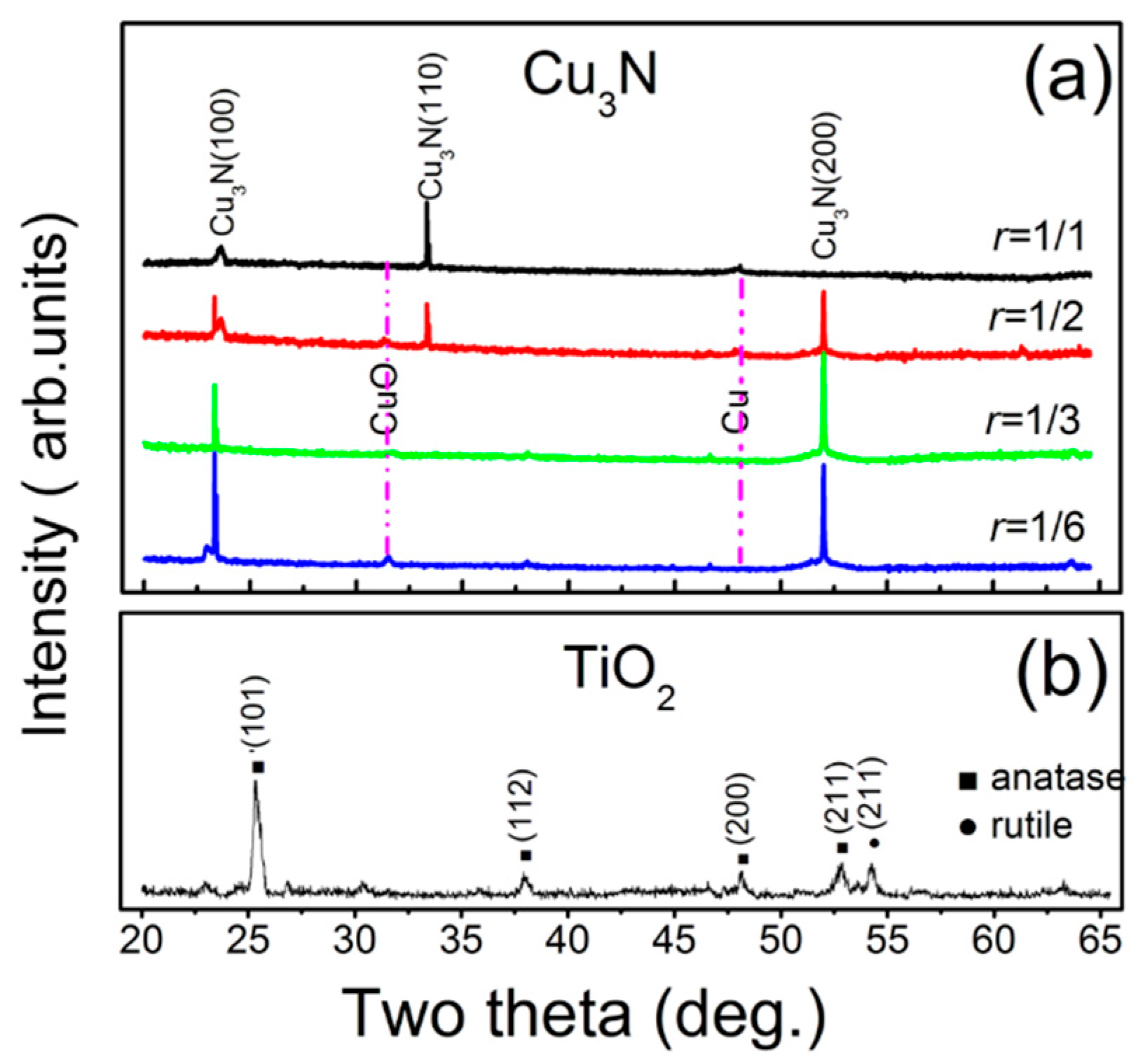
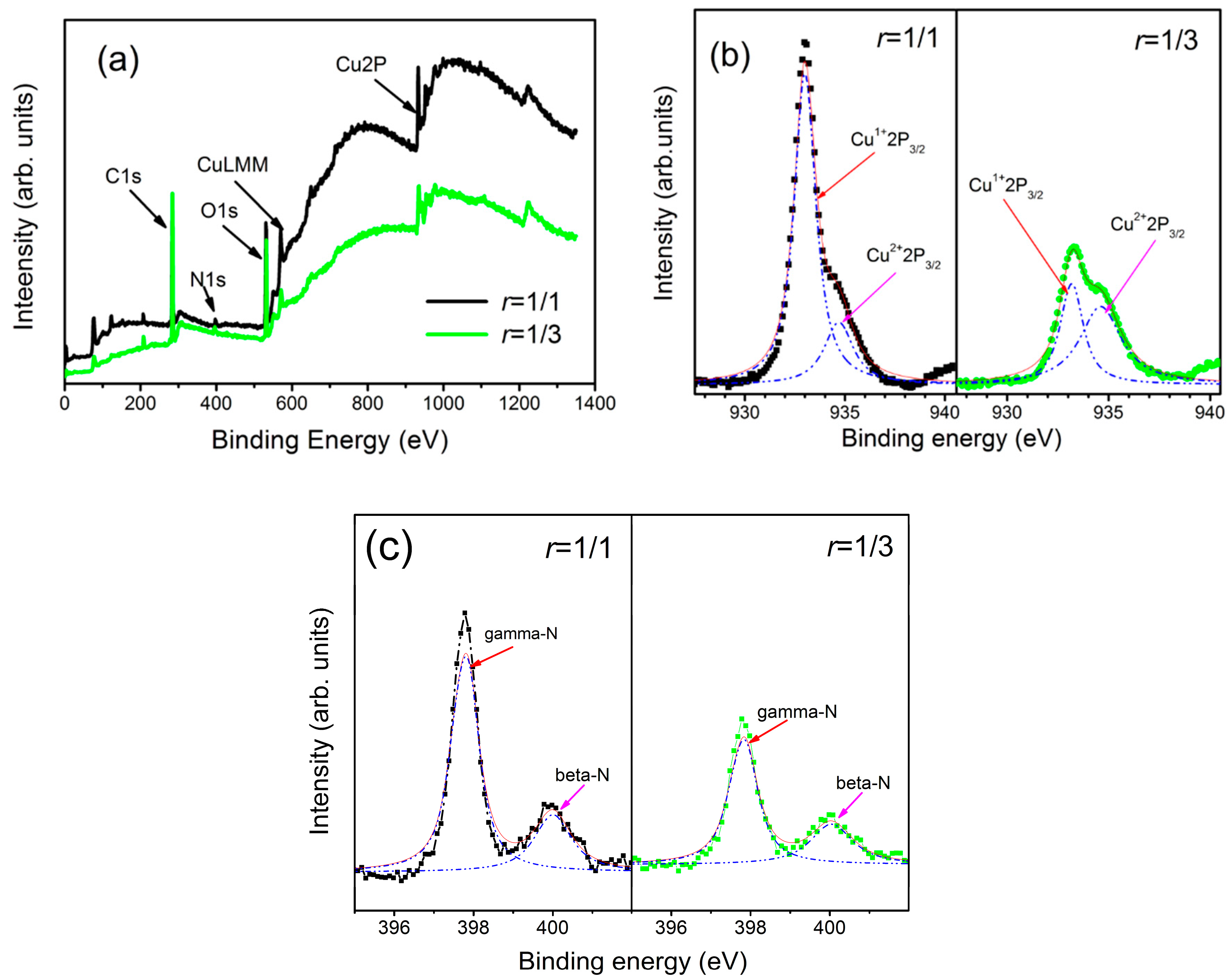
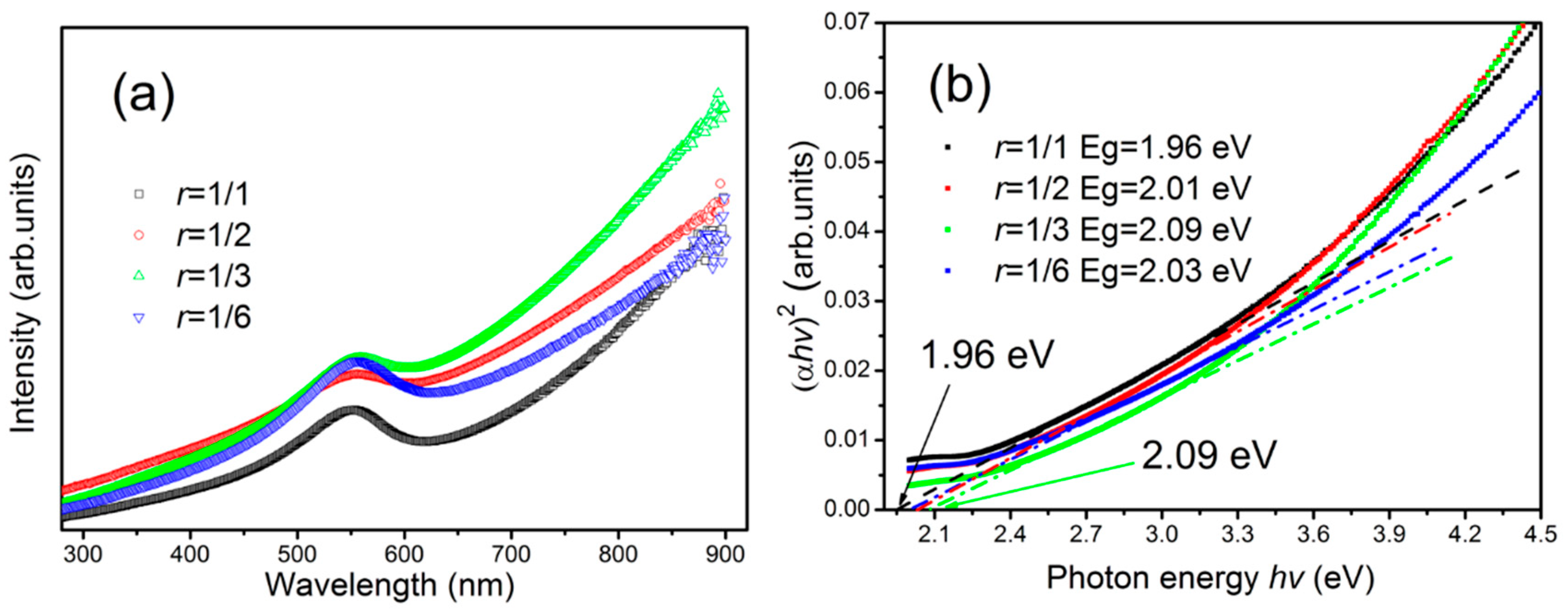
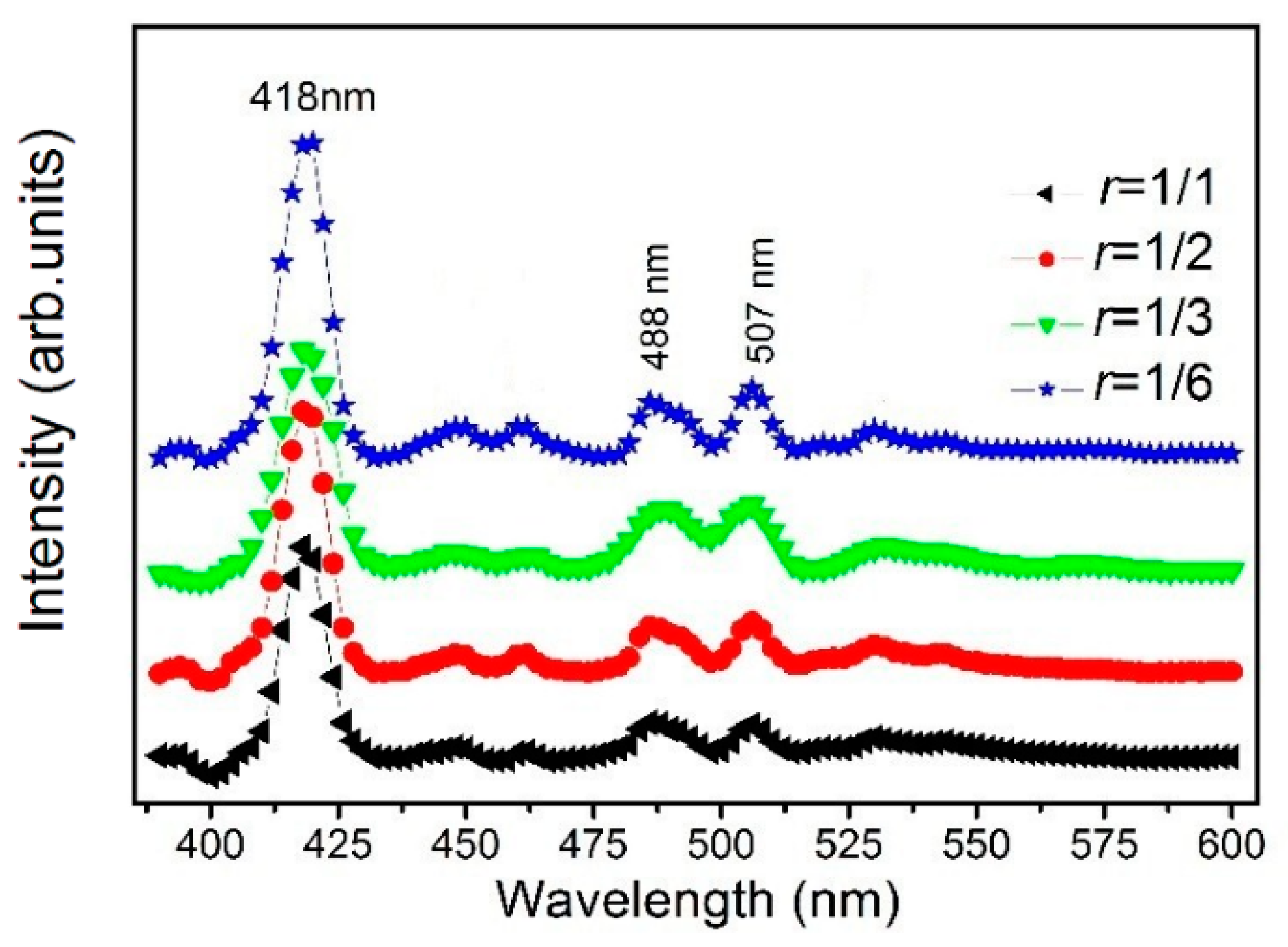
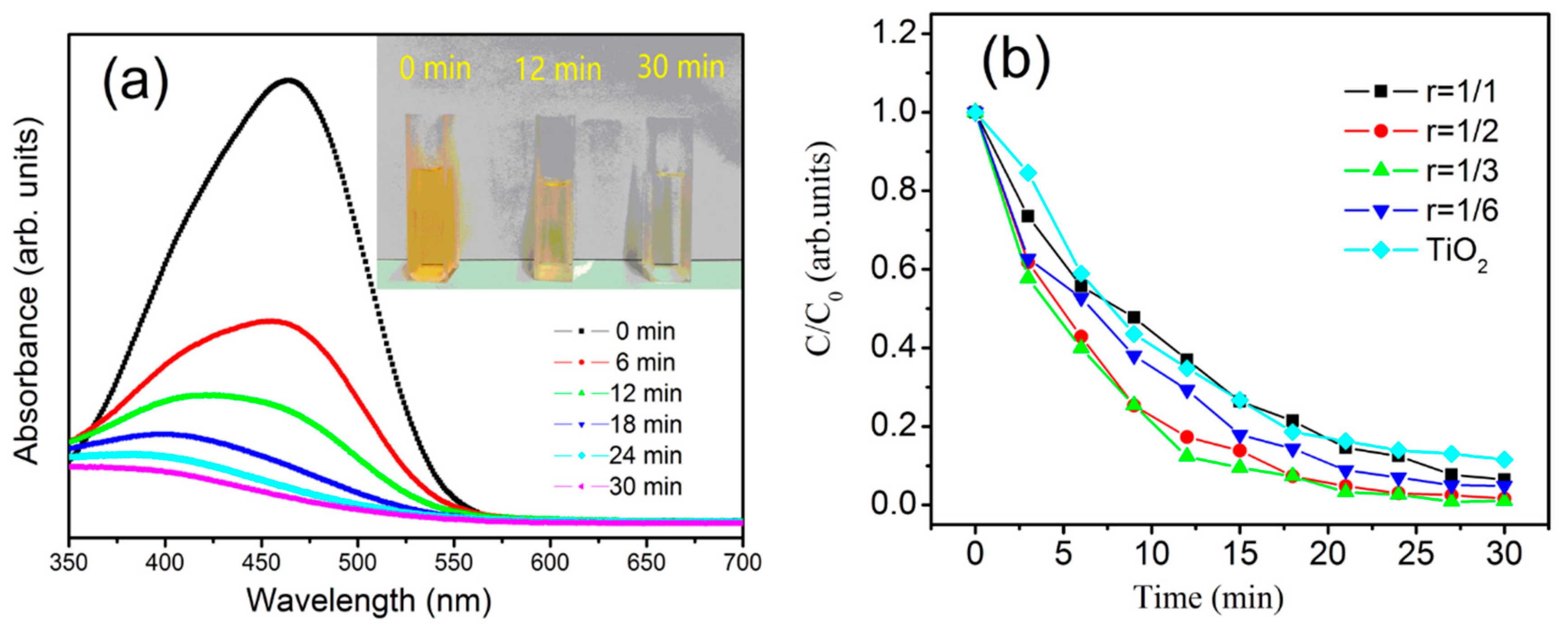
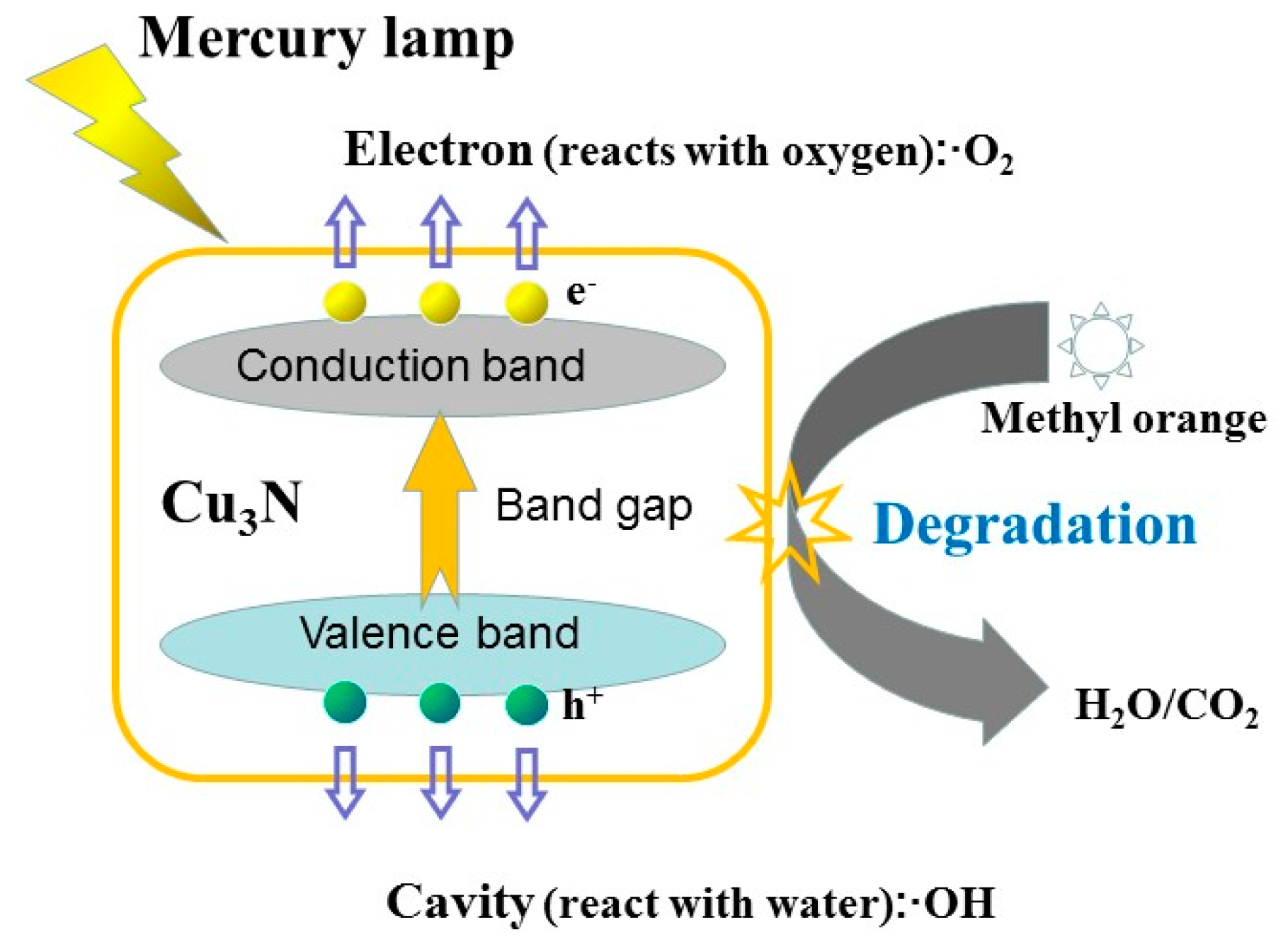
© 2020 by the authors. Licensee MDPI, Basel, Switzerland. This article is an open access article distributed under the terms and conditions of the Creative Commons Attribution (CC BY) license (http://creativecommons.org/licenses/by/4.0/).
Share and Cite
Jiang, A.; Shao, H.; Zhu, L.; Ma, S.; Xiao, J. Preparation of Copper Nitride Films with Superior Photocatalytic Activity through Magnetron Sputtering. Materials 2020, 13, 4325. https://doi.org/10.3390/ma13194325
Jiang A, Shao H, Zhu L, Ma S, Xiao J. Preparation of Copper Nitride Films with Superior Photocatalytic Activity through Magnetron Sputtering. Materials. 2020; 13(19):4325. https://doi.org/10.3390/ma13194325
Chicago/Turabian StyleJiang, Aihua, Hongjuan Shao, Liwen Zhu, Songshan Ma, and Jianrong Xiao. 2020. "Preparation of Copper Nitride Films with Superior Photocatalytic Activity through Magnetron Sputtering" Materials 13, no. 19: 4325. https://doi.org/10.3390/ma13194325




